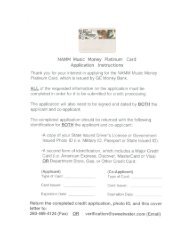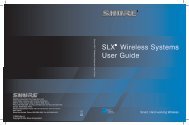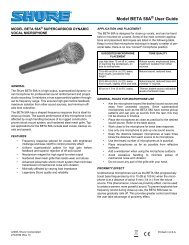You also want an ePaper? Increase the reach of your titles
YUMPU automatically turns print PDFs into web optimized ePapers that Google loves.
Effects List<br />
43: DELAY<br />
This is a stereo delay.<br />
When Feedback Mode is NORMAL:<br />
fig.MFX-43a<br />
L in<br />
R in<br />
Delay<br />
Feedback<br />
Feedback<br />
Delay<br />
Balance D<br />
Balance D<br />
2-Band<br />
EQ<br />
Balance W<br />
Balance W<br />
2-Band<br />
EQ<br />
L out<br />
R out<br />
Parameter Range Explanation<br />
Feedback -98– +98%<br />
HF Damp<br />
200–8000 Hz,<br />
BYPASS<br />
Proportion of the delay sound<br />
that is to be returned to the input<br />
(negative values invert the phase)<br />
Frequency at which the high-frequency<br />
content of the delayed<br />
sound will be cut (BYPASS: no<br />
cut)<br />
Pan L64–63R Panning of the delay sound<br />
Low Gain<br />
High Gain<br />
-15– +15 dB<br />
-15– +15 dB<br />
Balance D100:0W–D0:100W<br />
Level 0–127 Output volume<br />
Amount of boost/cut for the highfrequency<br />
range<br />
Amount of boost/cut for the highfrequency<br />
range<br />
Volume balance of the original<br />
sound (D) and delay sound (W)<br />
When Feedback Mode is CROSS:<br />
fig.MFX-43b<br />
Balance D<br />
L in<br />
Delay<br />
2-Band<br />
EQ<br />
Balance W<br />
L out<br />
45: SERIAL DELAY<br />
This delay connects two delay units in series. Feedback can be<br />
applied independently to each delay unit, allowing you to produce<br />
complex delay sounds.<br />
R in<br />
Parameter Value Description<br />
Delay Left<br />
Delay Right<br />
Phase Left<br />
Phase Right<br />
Feedback<br />
Mode<br />
A delay that provides a long delay time.<br />
fig.MFX-44<br />
0–1300 ms,<br />
note<br />
NORMAL,<br />
INVERSE<br />
NORMAL,<br />
CROSS<br />
Feedback -98– +98%<br />
HF Damp<br />
200–8000 Hz,<br />
BYPASS<br />
Adjusts the time until the delay sound is<br />
heard.<br />
Phase of the delay sound<br />
Selects the way in which delay sound is fed<br />
back into the effect. (See the figures above.)<br />
Adjusts the amount of the delay sound that’s<br />
fed back into the effect. Negative<br />
(-) settings invert the phase.<br />
Adjusts the frequency above which sound fed<br />
back to the effect is filtered out. If you don’t<br />
want to filter out any high frequencies, set this<br />
parameter to BYPASS.<br />
Low Gain -15– +15 dB Gain of the low frequency range<br />
High Gain -15– +15 dB Gain of the high frequency range<br />
Balance<br />
Feedback<br />
Feedback<br />
Delay<br />
D100:0W–<br />
D0:100W<br />
Level 0–127 Output level<br />
44: LONG DELAY<br />
L in<br />
R in<br />
Feedback<br />
Balance D<br />
Long Delay<br />
Balance W<br />
2-Band<br />
EQ<br />
R out<br />
Volume balance between the direct sound<br />
(D) and the delay sound (W)<br />
Pan L<br />
Pan R<br />
2-Band<br />
EQ<br />
2-Band<br />
EQ<br />
L out<br />
R out<br />
fig.MFX-45<br />
L in<br />
R in<br />
Parameter Range Explanation<br />
Delay1 Time<br />
Delay1<br />
Feedback<br />
Delay1 HF Damp<br />
Delay2 Time<br />
Delay2<br />
Feedback<br />
Delay2 HF Damp<br />
0–1300 ms, note<br />
-98– +98%<br />
200–8000 Hz,<br />
BYPASS<br />
0–1300 ms, note<br />
-98– +98%<br />
200–8000 Hz,<br />
BYPASS<br />
Delay time from when sound is<br />
input to delay 1 until the delay<br />
sound is heard<br />
Proportion of the delay sound<br />
that is to be returned to the input<br />
of delay 1 (negative values invert<br />
the phase)<br />
Frequency at which the high-frequency<br />
content of the delayed<br />
sound of delay 1 will be cut (BY-<br />
PASS: no cut)<br />
Delay time from when sound is<br />
input to delay 2 until the delay<br />
sound is heard<br />
Proportion of the delay sound<br />
that is to be returned to the input<br />
of delay 2 (negative values invert<br />
the phase)<br />
Frequency at which the high-frequency<br />
content of the delayed<br />
sound of delay 2 will be cut (BY-<br />
PASS: no cut)<br />
Pan L64–63R Panning of the delay sound<br />
Low Gain<br />
High Gain<br />
Delay 1<br />
Feedback 1<br />
-15– +15 dB<br />
-15– +15 dB<br />
Balance D100:0W–D0:100W<br />
Delay 2<br />
Feedback 2<br />
Level 0–127 Output volume<br />
Pan L<br />
Pan R<br />
L out<br />
R out<br />
Amount of boost/cut for the lowfrequency<br />
range<br />
Amount of boost/cut for the highfrequency<br />
range<br />
Volume balance of the original<br />
sound (D) and delay sound (W)<br />
Parameter Range Explanation<br />
Delay Time<br />
Phase<br />
0–2600 ms, note<br />
NORMAL, INVERSE<br />
Delay time from when the original<br />
sound is heard to when the<br />
delay sound is heard<br />
Phase of the delay (NORMAL:<br />
non-inverted, INVERT: inverted)<br />
71
















